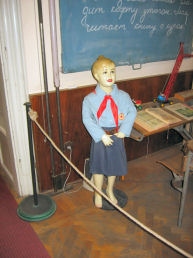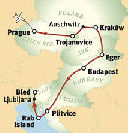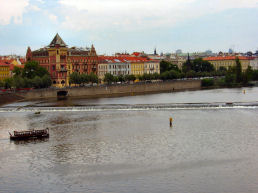Sue and I ate breakfast with Nedra Slausen. She has evidently traveled a great deal. Just about everyone in this group has been to Europe several times.
The group met outside the hotel and walked to the Metro stop. Our destination was Prague Castle, which is on the western side of the Vltava river. The escalator seemed to be very long, very steep, and very fast. We took the yellow line for one stop and then the green line for two stops. The subways seemed very clean and efficient. I have never understood why cities in the U.S. seem incapable of providing decent subwary service. We all then took tram #21 up to the vicinity of the castle. A very tall, very good looking young Czech girl got on the tram with us. There seemed to be quite a few members of that species around Prague. Šárka awaited us at the tram stop. She told us that Prague now receives ten million tourists a year. In her opinion the Czech people were not ready to entertain so many people. She also claimed that the Czechs generally have low self-esteem and are therefore suspicious of strangers. Šárka exhibited one slightly eccentric mannerism. She always moved her sunglasses back on her head whenever she addressed us. I heard her mumble that she had been taught that it was impolite to wear them when talking to someone. We entered the castle grounds, which were still the site of some government offices, and official government functions were often held there. In some locations armed soldiers were in evidence. I was surprised to spot one of them wearing camos. It has always seemed so stupid to me for soldiers stationed in large cities to dress as if they were deployed in the jungle or the desert. I gave Europeans credit for being sensible enough to realize this.We first went into a large hall. Šárka said that they had actually staged indoor jousting and other such activities in the hall.
We learned that a fire in 1541 destroyed Little Town, the area between the castle and the river. It also inflicted serious damage on the castle. Essentially everything flammable burned.
We then had to get in line to enter St. Vitus's Cathedral, which was situated within the castle grounds. It was still an operational church, but they treated it like a museum. It was somehow jointly owned by the Catholic Church, which is not that strong in the Czech Republic, and the national government! Photography, even flash photography, was allowed in the Church, but tripods were prohibited. Sue suggested that this rule was probably designed to exclude professional photographers.On the outside of the Church were numerous gargoyles. Šárka explained that their primary function was to keep out the devil, who, according to legends, is afraid of his own face. They also served as rain spouts.
The cathedral contained the crypt of "King" Wenceslas. Prominently displayed was a painting of him and his mother, St. Ludmilla. Wenceslas died at 20 at his brother's hand. His mother was killed by her own daughter. The painting depicted Wenceslas's dastardly brother in a turban. His garb was evidently meant to indicate that he was a pagan. I understood this reasoning perfectly. The nuns taught us that all non-Catholics were heathens. We learned that St. Vitus was associated with light, because the family that funded the constuction of the church was named Luxemburg, and "lux" is the Latin word for light. St. Vitus has also been associated with the rooster, which served as a symbol of the first light of the day.Šárka told us the story of Jan Nepomuk, a fourteeth-century priest who was the queen's confessor. The king tried to get him to reveal the sins that the queen had admitted to in confession, but Nepomuk refused to do it. So the king's men bopped him on the head and threw him off the Charles Bridge. He floated. When the people dug him up later, they found something pink inside his skull. They thought that it was his tongue, and they concluded that it was a sign from heaven of his holiness for not ratting on the queen. He was canonized as a saint. Scientists later disclosed that the pink thing was what was left of his brain, not his tongue. Jan Nepomuk is always shown with stars in his halo. Supposedly when he landed in the water these stars appeared to the onlookers. Šárka also reported that the Church tried to use Jan Nepomuk as a substitute for Jan Hus, who had been condemned as a heretic but was still revered in Prague.
On one wall of the church there are symbols of the Czech (lion) and Slovak (bear?) peoples. The same fresco contains Hus's last words, "Pravda vítězí" (the truth prevails), which Vaclav Havel also took as his slogan.
Parts of the cathedral are extremely old. However, other sections have been added on in subsequent centuries.
Susana produced tickets that allowed us to tour the rest of the castle. The seniors got a reduced rate. There was not really that much to see in the castle proper. In the first room Šárka pointed out the ceiling, which was a net of intersecting Y's. This technique, called net vaulting, was developed by the architect, Peter Parler, in the fourteenth century. He might have belonged to an early form of freemasonry.
Šárka showed us where the Czechs had defenestrated the Hapsburg governors and started the Thirty Years War. She told us several times that the Catholics won the war. It certainly is true that the war turned out badly for the Czechs, but the final peace settlement also weakened the Hapsburg's power. Sweden got great chunks of land on the lower continent. Richelieu's France, which fought on the side of the Protestants, picked up some territories as well.
We were then given a few minutes to explore a few rooms on our own and look at the views. The castle sits high over Prague. The vistas were quite good, but the haze made it very difficult to compose a clear photo that included much of the landscape. Šárka said that the Linden tree is the national tree of the Czech Republic. She also remarked that very little snow fell in Prague over the winter of 2006-2007. As a result the trees and grass were dry. I noticed the same small tags in the curbs that I had previously seen all over Prague. They said "Silver Line Golden Prague." I never discovered what they were.
We marched up toward the monastery as a group. We were just in time to watch the changing of the guard. There was not that much to see. The army musicians stood in windows nearby and played uninspiring march tunes to accompany the ceremony. The Czech army needs more imaginative uniforms – maybe halberds like the Swiss guards (and the wicked witch of the west's army), or busbies like the British (and the wicked witch of the west's army), or skirts like the Greeks and Scots.
One building was painted with light squares and dark triangles to give a three-D effect. Šárka said that this was called graffito. She also claimed that graffito was the Italian word for envelope [Only the plural, graffiti, which means just what you might think, was in my Italian dictionary], unless I misunderstood her. The figures on the wall certainly looked like envelopes.
A little farther up the street Šárka pointed out Loreta, a shrine run by Capuchin monks. It featured a copy of the alleged birthplace of Mary, which is located in Loreto, Italy. The Czech facility also had a poppular chapel dedicated to St. Wilgefortis, the young Portuguese woman who miraculously grew a beard overnight to avoid an arranged marriage. Her father was so upset at her that he crucified her. Šárka passed around a postcard which depicted the saint's demise. We then passed by the monastery, which was run by the Premontrententians, a splinter group of former Benedictines founded by St. Norbert. They apparently wore white robes, but I did not see any monks. Their fame was derived from their library and their brewery, Klašterní Pivovar Strahov. The vote was very close, but the group decided to spend time in the latter rather than the former.
The brewery's atmosphere was relaxing. The interior was decorated with posters and knickknacks screwed onto the wall. The Connecticut contingent ate with Steve, Janet, Angela, and Rawlins. I had goulash and dumplings, which I really enjoyed.

Steve and Janet then joined the New Englanders as we headed back across the river. We took the tram. We had been advised to take tram #21 or #22. It took us a while to find the tram stop, but almost as soon as we got there #15 arrived, then #3, and finally #22, our tram. It was almost empty when we got on, so we got to sit all the way. We took the same tram down from the castle, through Little Town, and across the bridge into New Town. It was quite full when we got off near the moat street, Napřikopě. I once again marveled as to why America's public transportation was so pitiful.
The other five (or maybe four) wanted to go to the Black Light Theater, which was not of much interest to me. I had seen Laterna Magica at the Word's Fair in Montreal, and it did nothing for me. Sue went off on her own to do postcards. The rest of us walked down to the Old Town Square to get the tickets. We agreed to meet Sue at the Mucha Museum. As we started to walk toward Old Town Square, it began to rain. Fortunately I had brought my umbrella. Even though it was a little the worse for wear since the two of us had been caught in the wind and rain in New York City the previous week, it kept me pretty dry.
It turned out that the Tourist Information Office right in the Old Town Square sold the tickets to Image, the recommended Black Light Theater. They even had tickets for that evening's performance. Sue had evidently been ambivalent about whether she wanted to go. Tom bought her a ticket and entrusted me with giving it to her.
The five of us then walked in the light rain up to the Museum of Communism. It was a little difficult to find. We had to walk through McDonald's. Then it appeared that we were entering a casino. We had to locate the stairs that led to the museum. A group of about twenty young people entered just ahead of us, but for some reason they were hesitant about buying tickets. Janet led us past them, and we went right in. The admission was 180Kč. I liked this exhibit. It contained a great deal of information. Numerous statues and exhibits of what stores and schools looked like under Communism were dispersed throughout five or six rooms. It gave you a pretty good feel about what the Czech people have gone through. We got to see the kind of uniform that Šárka must have had to wear when she was a kid.
Sue spotted me almost as soon as I entered. I put my backpack in locker #37, bought a ticket, and walked in. I had seen some of Mucha's posters before, but I knew nothing about him. Before I started going on these trips to Europe, I knew absolutely nothing about art. Now I know next to nothing. Sue and I watched the film about Mucha's life and his lifelong quest to create a Slav Epic. I was most interested in the historical aspect. He evidently was responsible for the resurrection of Jan Hus as a Czech hero. Šárka had told us that the Communists had called Hus the first Czech Communist.
We went back to the hotel shortly after watching the film. Sue, who was a little irritated that Tom had bought the ticket for her, got ready for the theater. Patti came by to pick Sue up, but she was still in the shower. I had to give Sue credit, however. She made it to the theater on her own and even got to sit with the Corcorans and the Sharps. I went by myself to the Internet café at the Kotva department store. I had a slightly cold Diet Pepsi while I looked at my accumulated e-mail. I sent my dad an e-mail, but I was uncertain whether he would be able to read it. I knew how to put it in 18 pt. on my PC, but I was unfamiliar with the web-based e-mail client. There was also a rather disturbing work-related e-mail that I felt needed to be addressed.I then set out to get a little Slovakian and Croatian currency as Susana had advised us to do. I went to three exchange kiosks. One had no Slovakian or Croatian currency. One would only sell me units of five hundred crowns of Slovakian currency. This was more than I wanted. The last would only sell in lots of one thousand. I gave up.
I walked to the Charles Bridge. I wanted to see why the bridge was considered such an attraction. It was pleasant enough. I looked at quite a few of the statues of saints. One of them intrigued me greatly. A lot of ferocious-looking animals were entering or exiting caves on the base of the statue of some saint. There was no sign on this statue, so I could not ascertain the saint's identity. I hoped that the guidebook would say, but it did not. St. Anthony of Padua appeared to be wearing a propeller-beany.
On the bridge I noticed a guy in a white sailor suit wearing flip-flops. I could not think of an explanation for that combination of attire. I later saw a bunch of similarly clad young men hawking tickets for boat rides.
I went across the bridge and noodled around in Little Town for a few minutes. I wanted to see the interior of St. Nicholas Cathedral. I did not do so because I could not find the door. That seemed to be a pretty strange problem to face. I also remembered that they had concerts every evening, so I would not be able to go in any way. I therefore did not expend a lot of effort looking for the entrance. I later learned that they do not hold concerts on Tuesdays.
I then hung around south of the bridge waiting for it to get dark so that I could take better photos of the bridge and castle at night. It was quite overcast, so it was hard to tell when the sun would set. I waited until 8:15, but it was still light out. Then a north wind came up, and it became too cold for me, so I trekked back to the hotel.
As soon as I arived at the hotel I felt overwhelmed with melancholy. I decided to take a shower. As I was about to step into the stall, I heard a knock at the door. Tom asked me if I wanted to go out with them. I declined. I asked him where Sue was, and he told me that she was at the Internet café. I took a shower and then waited for her to return to the room. When she did, she told me that she thought that the show had been so-so, and I would have hated it.
Sue found out how to make an international call from the hotel room. We called the office. I ran up an outrageous bill talking to Denise about what to do about the proposal that I had been unable to finish before we left. This did not help my mood.
Afterwards I went down to the desk and paid for the phone calls. It used up just about all my Czech money. Then I tried to go to sleep.
Prague reminded me of Venice. They were both quite artsy and very crowded with tourists. The ones in Prague seemed very young. I liked the Italian approach better. There also seemed to be much more to do in Venice. I was still looking forward to the opera when we returned in a couple of weeks, but beyond that I had no great desire to return to either Venice or Prague, at least at that moment.























































